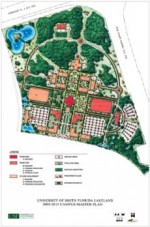USF Lakeland expands to new, independent campus

The spirit of USF is present in the banners that line the parking lot of USF Lakeland (USFL). From the moment you drive onto the campus, however, it’s apparent that it’s far from the bustling atmosphere of the Tampa campus.
You find the free parking spots and can calmly walk to class about 30 seconds away. There are no parking garages – nor the need for them. There are even signs that ask if you remembered to turn off your car lights.
The campus shares its space with Polk Community College. The first building, the Lakeland Technology Building, is divided. To the left side of the building, you can see Bulls pride displays. To the right side, you see signs for Viking pride.
Boosted by a large donation, however, USFL will change that with an expansion of its campus at a completely different site.
Donated by The Williams Co., a natural gas company, the land is located near the corner of the Polk Parkway and Interstate 4 in Polk City. The campus will be no more than five minutes from I-4.
About a 15-minute drive from the current campus on the Polk Parkway, the layout for the new campus features residence halls, two parking garages and 13 academic buildings. Right now, however, administrators are concerned about breaking land with the first building.
“There is a committee trying to determine what exactly will be housed in that building,” USFL Director of University Advancement David Steele said. “Right now, the first building on campus will have to house teaching space (and) certainly some offices.”
During Phase I, only one building and some surface parking will be built. Upon completion of the initial step, Phase II would begin, consisting of five structures, one of them a possible parking garage.
Although the expansion will be a moderate drive from the current campus, USFL will continue to hold classes in both institutions.
“We’re not planning to vacate our current campus,” Steele said.
To aid its expansion, USFL has requested $35 million from the State University System to be spent over the next three years. In 2008-2009, $15 million will be used, with $10 million for the each of the next two years. In addition to the $35 million, USFL has received donations from local and private parties.
“(A) gift is coming from the Lakeland economic development council,” Steele said. “The first $3 million check has been received by the USF Foundation.”
The gift totals $5 million, with the other $2 million to be disbursed in the next two years. The Central Florida Development Council also gave $5 million, but in one check. Additionally, USFL can apply for grants from the state that will match the amount given to them by private parties. Its goal is to have $65 million to begin construction. The University is $10 million short of that, even with the requested $35 million.
“It’s just undeveloped land,” Steele said.
Ultimately, USFL is striving to be more than a smaller version of the Tampa campus. It would make itself unique by emphasizing applied teaching and research.
“The regional campuses can be distinctive,” Vice President of University Communications Michael Hoad said. “Lakeland is responding to the need of that economy, which has more technically skilled workers.
“It means that USF is a system of campuses and colleges. There isn’t another system like this in Florida where the regional campuses can get their own accreditation.”
“There may be disciplines that Tampa offers,” Steele said. “But the way we approach them may be different.”
When discussing the name of the new campus, the focus has been its specialty.
“The name that has been discussed by our campus board is ‘USF Polytechnic’ – but no name change has been finalized,” he said. “We’re technically not USF Polytechnic yet.”






